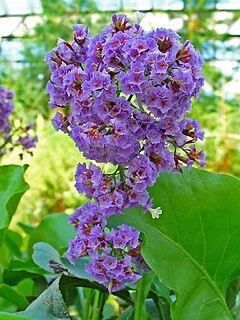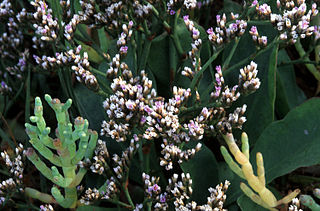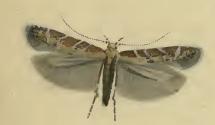
Limonium is a genus of 120 flowering plant species. Members are also known as sea-lavender, statice, caspia or marsh-rosemary. Despite their common names, species are not related to the lavenders or to rosemary. They are instead in Plumbaginaceae, the plumbago or leadwort family. The generic name is from the Latin līmōnion, used by Pliny for a wild plant and is ultimately derived from the Ancient Greek leimon.

Limonium binervosum, commonly known as rock sea-lavender, is an aggregate species in the family Plumbaginaceae.

Sparganothis pilleriana, also known as the vine leafroller tortrix, is a moth of the family Tortricidae found in the Palearctic realm. It was first described by the Austrian lepidopterists Michael Denis and Ignaz Schiffermüller in 1775.

Duponchelia fovealis is a species of moth of the family Crambidae described by Philipp Christoph Zeller in 1847. It is endemic to the area surrounding the Mediterranean Sea, and the Canary Islands, but has extended its range to other parts of Africa, Europe, the Middle East and North America.

Coenonympha nipisiquit, the maritime ringlet, is a rare butterfly in the family Nymphalidae. It is a "species at risk" in Canada due to water pollution and its limited range. Its range is restricted in Canada to the Chaleur Bay region, between New Brunswick and the Gaspé Peninsula.

Limonium arboreum is a species of sea lavender known by the common name tree limonium and siempreviva. It is endemic to the Canary Islands, where it is a plant of coastal habitat.

Limonium californicum is a species of sea lavender in the family Plumbaginaceae. It is known by the common names western marsh rosemary and California sea lavender.

Limonium perezii is a species of Limonium known by the common names Perez's sea lavender and seafoam statice. It is also known as simply statice, sea lavender or marsh rosemary. It is native to the coasts of the Canary Islands but are widely used in gardens throughout the world.

Agdistis meridionalis, the sea-side plume, is a moth of the family Pterophoridae, first described by the German entomologist Philipp Christoph Zeller in 1847. It is found in Europe.
Agdistis tamaricis is a moth of the family Pterophoridae found in Africa, Asia and Europe. It was first described by the German entomologist, Philipp Christoph Zeller in 1847.

Agdistis intermedia is a moth of the family Pterophoridae. It is found from Hungary and Romania, east to Russia and Kazakhstan.
Agdistis frankeniae is a moth in the family Pterophoridae. It is found from Siberia through Central Asia, the northern parts of Asia and North Africa along the Mediterranean and in the west from the Canary Islands to southern France.

Agdistis adactyla is a moth in the family Pterophoridae. It is known from most of the Palearctic realm, from central and south-western Europe to eastern Asia. Records including China, Mongolia, Afghanistan, Pakistan, Iran and Turkey.
Agdistis bifurcatus is a moth in the family Pterophoridae. It is known from Cape Verde, the Canary Islands, Morocco, Tunisia, the Selvagens Islands, Spain and Portugal.
Agdistis paralia is a moth in the family Pterophoridae. It is known from Spain, France, Italy, Malta, Greece, Israel, Turkmenistan, Tunisia, Algeria and Morocco. It has also been recorded from China (Gansu).

Aristotelia brizella is a moth of the family Gelechiidae. It is found in most of Europe, except Ireland, Switzerland and most of the Balkan Peninsula. Outside of Europe, it is found in North Africa and the Near East.

Limonium bellidifolium, commonly known as the matted sea-lavender, is an aggregate species in the family Plumbaginaceae.

Limonium narbonense is a species of sea lavender belonging to the family Plumbaginaceae.

Pseudaplemonus limonii is a species of weevil from the Apioninae subfamily. It lives on Common sea-lavender on the coasts of western Europe and northwest Africa.

Limonium vulgare, called common sea-lavender, is a species of flowering plant in the genus Limonium native to the Azores, western Europe, and southwestern Sweden, and introduced elsewhere. A clumping perennial found in salt marshes and other maritime habitats, it is a probable species complex.















